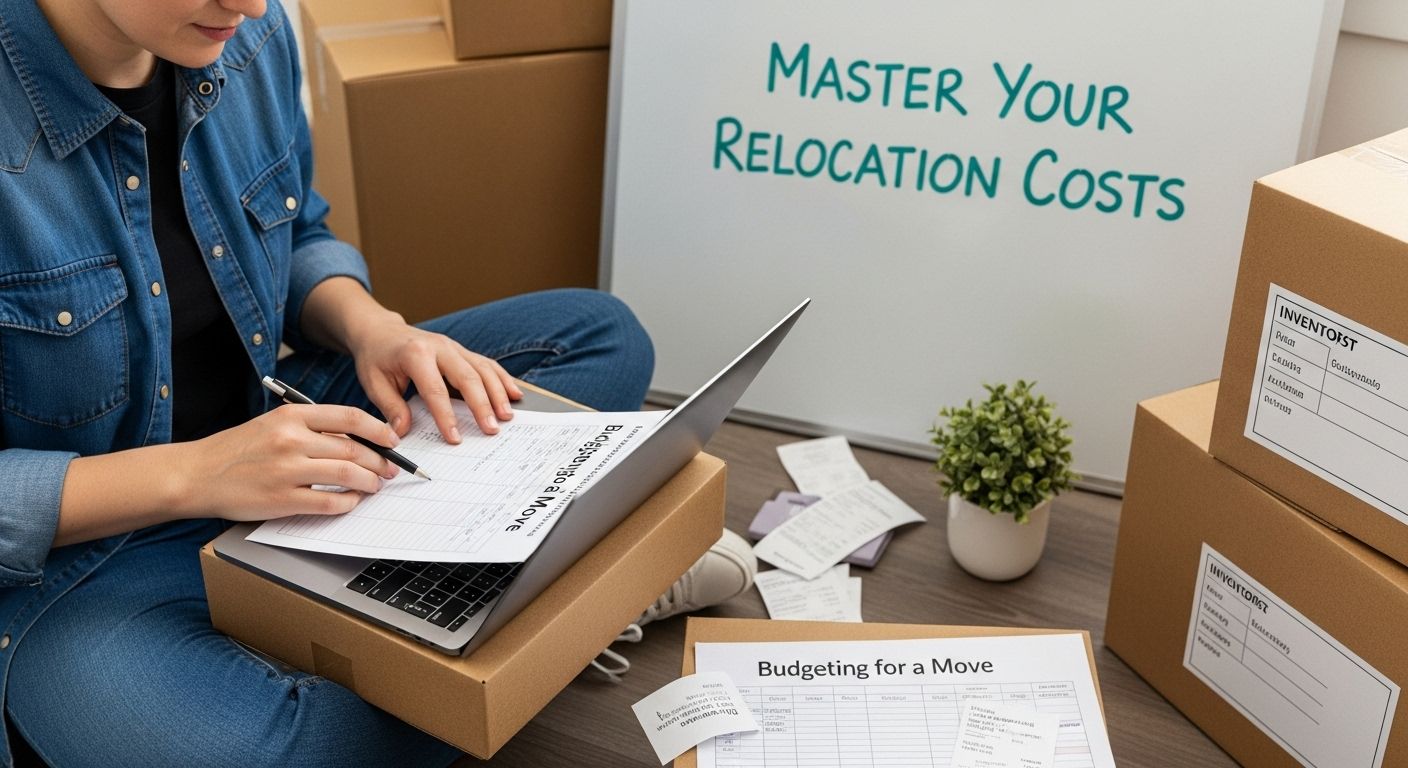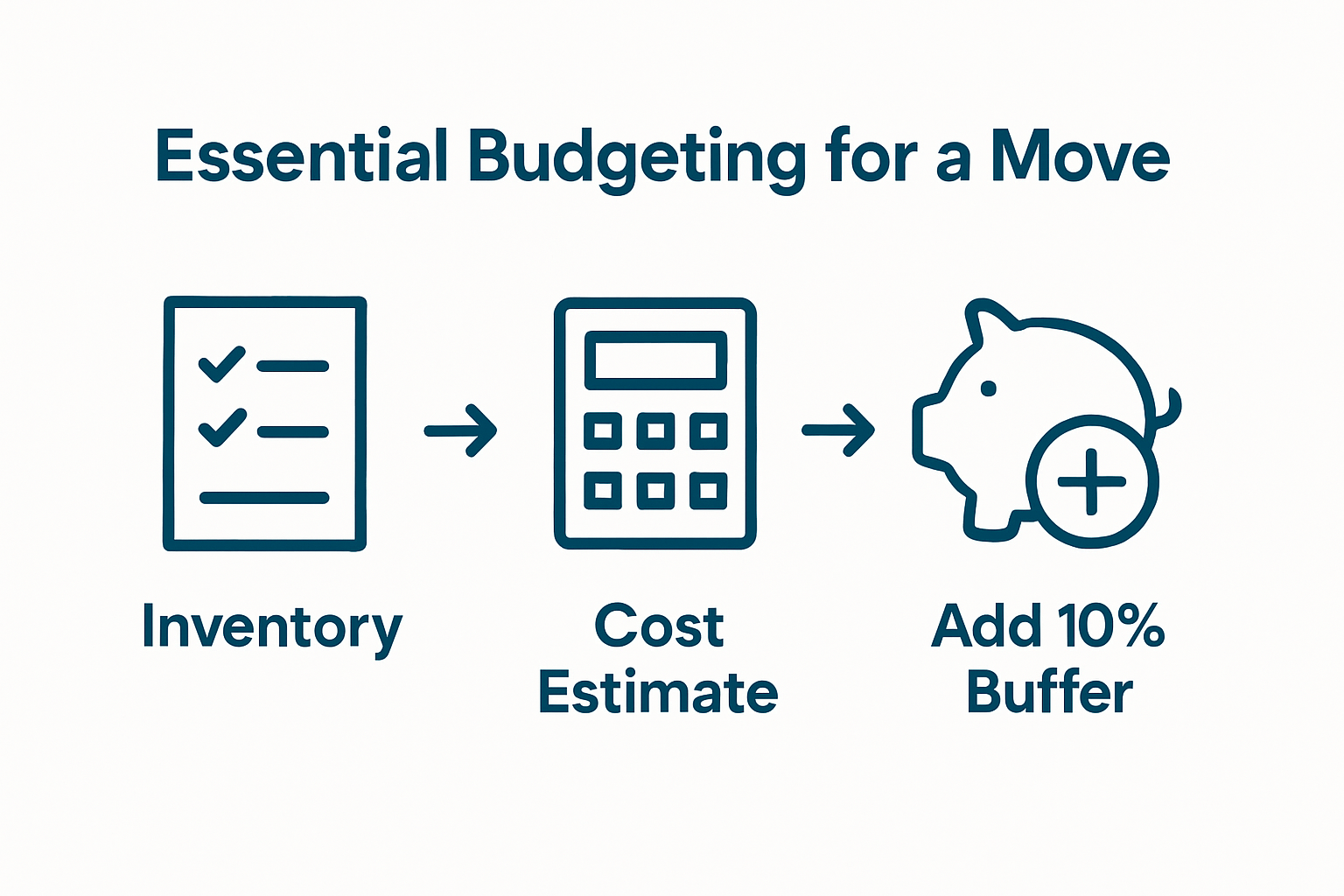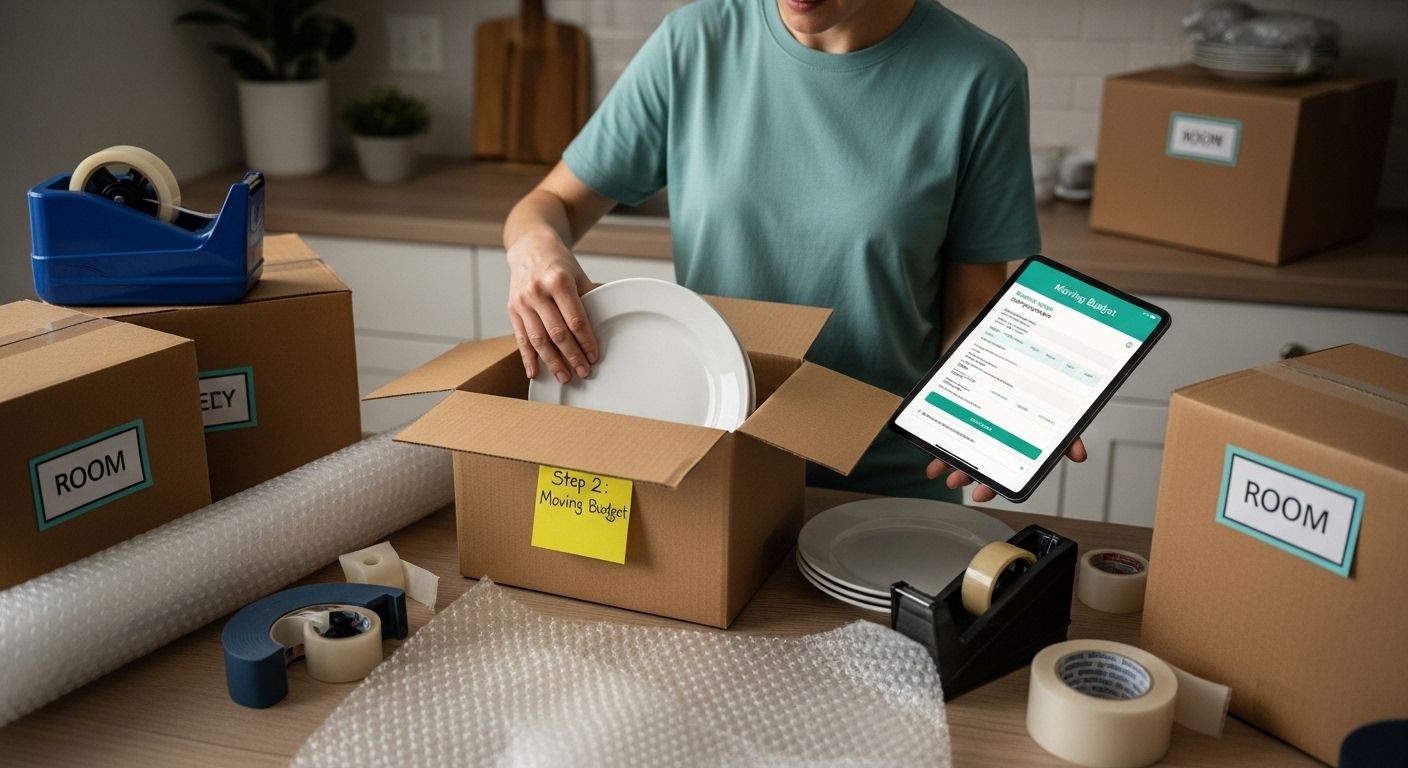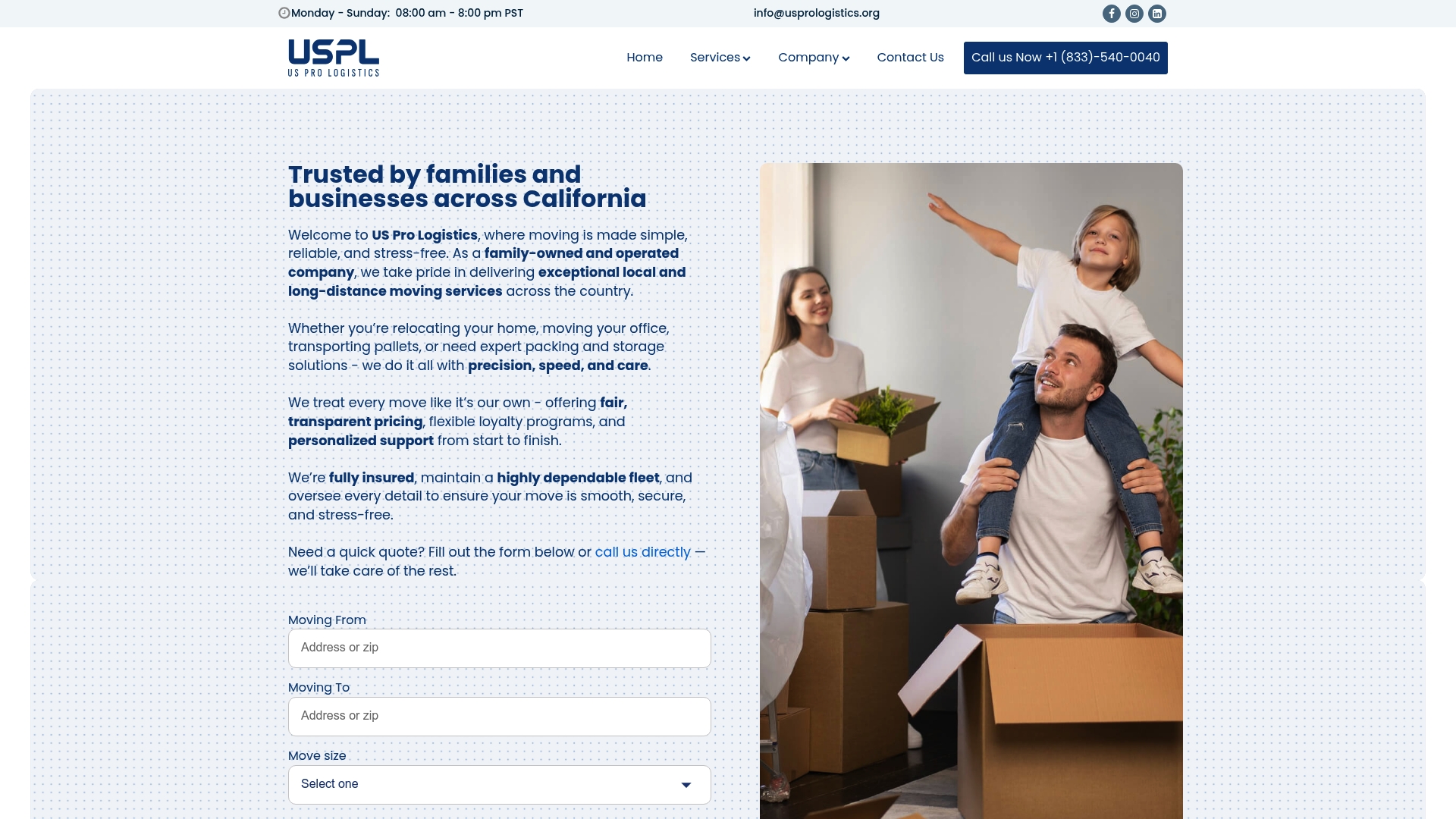
Planning a move can feel like a puzzle with too many missing pieces and not enough time to find them. The average cost to move a 2-3 bedroom home just 250 miles ranges from $2,272 to $4,343, which often catches people off guard. Yet the real surprise is how many people skip a crucial first step that could save thousands—not knowing what to track and when to act almost always drains their time and budget more than the distance of the move itself.
| Key Point | Explanation |
|---|---|
| 1. Evaluate Moving Needs First | Conduct a comprehensive inventory of your belongings to determine complexity and cost before any other steps. |
| 2. Create a Detailed Budget Template | Use a spreadsheet to categorize and estimate all moving expenses, including a buffer for unexpected costs. |
| 3. Research Moving Services Thoroughly | Compare at least three moving companies by requesting detailed estimates and verifying their credentials to ensure reliability. |
| 4. Lock in Moving Date and Budget | Choose an optimal moving date, ensuring it aligns with your budget, to avoid unexpected costs during peak times. |
| 5. Review Expenses Post-Move | Analyze actual expenditures against your budget to identify discrepancies and improve financial planning for future relocations. |
Evaluating your moving requirements and costs is the foundational step in creating a successful and stress-free relocation budget. This critical initial phase involves a comprehensive assessment of your specific moving needs, potential expenses, and logistical challenges. Your goal is to develop a clear, realistic financial roadmap that covers every aspect of your upcoming move.
Start by conducting a thorough inventory of your belongings, which serves as the primary determinant of your moving complexity and cost. Walk through each room in your current residence and catalog items by category: furniture, electronics, fragile items, and specialty possessions that might require special handling. Professional movers typically calculate costs based on weight and volume, so understanding the extent of your household contents becomes crucial. Consider whether you’ll need professional packing services, which can add significant expense but also provide valuable protection for your belongings.
Next, determine the specifics of your move distance and type. Local moves within the same city will have dramatically different cost structures compared to long-distance or interstate relocations. Learn more about cross-country moving strategies that can help you anticipate potential challenges and budget effectively. According to research from Duke University, moving a 2-3 bedroom home approximately 250 miles can range between $2,272 and $4,343, highlighting the importance of obtaining multiple quotes and understanding regional pricing variations.
Finally, factor in additional expenses beyond basic transportation. These often overlooked costs include temporary storage fees, insurance coverage, potential travel expenses, utility connection charges, and potential overnight accommodations. Create a comprehensive spreadsheet tracking every anticipated expense, allowing for a 10-15% buffer to manage unexpected circumstances.
To help you track essential items and ensure nothing is overlooked, here is a checklist table summarizing common moving-related expenses to include in your budget template.
| Expense Category | Description | Example Costs/Details |
|---|---|---|
| Packing Materials | Boxes, tape, bubble wrap, packing paper | Cardboard boxes, specialty containers |
| Transportation | Cost of rental truck or professional movers | Based on mileage/weight/volume |
| Professional Services | Moving company fees, packing services | Labor charges, handling fees |
| Travel Expenses | Fuel, meals, lodging during move | Gasoline, hotel for overnight stay |
| Insurance | Coverage for belongings in transit | Moving insurance, valuation protection |
| Storage Fees | Temporary storage before or after move | Storage unit rental |
| Utility Connections | Setting up or disconnecting utilities | Activation/cancellation fees |
| Contingency Fund | Extra buffer for unforeseen costs | 10-15% of total budget |

Creating a detailed moving budget template transforms your relocation from a potential financial minefield into a strategic, controlled process. This comprehensive financial blueprint will track every potential expense, prevent unexpected costs, and provide clarity throughout your moving journey. Think of your budget template as a financial roadmap that guides you through each stage of relocation with precision and confidence.
Begin by establishing a digital spreadsheet using platforms like Google Sheets or Microsoft Excel, which offer robust tracking capabilities. Divide your budget into clear, distinct categories that cover the entire spectrum of moving expenses. Your primary sections should include packing materials, transportation costs, professional moving services, travel expenses, insurance, storage fees, and a critical contingency fund. According to research from the U.S. Geological Survey, maintaining a granular breakdown helps identify potential savings and prevents financial overruns.
Populate your template with estimated costs based on your inventory and move complexity. Explore comprehensive moving strategies to refine your budget accuracy. Include columns for estimated cost, actual cost, and variance to track real-time financial performance. Allocate at least 10-15% of your total budget for unexpected expenses, which might include last-minute packing supplies, additional moving labor, or unforeseen transportation challenges. Regularly update your spreadsheet as you obtain quotes, make purchases, and progress through your moving timeline. This dynamic approach transforms your budget from a static document into an active financial management tool that adapts to your evolving moving needs. By the end of this process, you’ll have a clear, comprehensive financial plan that provides peace of mind and control during one of life’s most complex logistical challenges.

Researching and comparing moving services is a critical step that can significantly impact your relocation’s success and overall budget. This phase requires a strategic approach that goes beyond simply comparing price tags, focusing instead on comprehensive service quality, reliability, and alignment with your specific moving requirements. Your goal is to identify a moving partner that offers the best balance of professional expertise, cost-effectiveness, and personalized support.
Start by generating a comprehensive list of potential moving companies through multiple research channels. Leverage online platforms, professional moving directories, and recommendations from friends, family, and colleagues. Learn more about selecting the right moving company to refine your evaluation process. According to guidance from USA.gov, it’s crucial to verify each company’s licensing, insurance credentials, and complaint history before proceeding further. Utilize resources like the Federal Motor Carrier Safety Administration’s database to cross-reference company credentials and ensure legitimacy.
Develop a systematic approach to comparing moving services by requesting detailed written estimates from at least three different providers. Pay close attention to the breakdown of services, including packing, transportation, loading, unloading, and potential additional fees.
Request in-home or virtual assessments to ensure the most accurate pricing, as this allows movers to evaluate your specific requirements firsthand. Create a comparison matrix that tracks key factors such as estimated total cost, service inclusions, insurance coverage, available moving dates, and customer reviews. Look beyond the bottom line and consider intangible aspects like company reputation, communication responsiveness, and specialized handling capabilities for fragile or valuable items.
Here is a comparison table to help you systematically evaluate different moving companies based on factors mentioned in the article.
| Company Factor | Why It Matters | What to Check/Compare |
|---|---|---|
| Licensing & Insurance | Ensures reliability and protection | FMCSA database, certificate of insurance |
| Written Estimate | Provides cost transparency | Detailed breakdown of services |
| Service Inclusions | Defines what is/isn t covered | Packing, loading, transport, unloading |
| Customer Reviews | Reveals service quality and satisfaction | Verified ratings, recent testimonials |
| Moving Date Availability | Alignment with your schedule | Peak vs. off-peak options |
| Track Record/Reputation | Indicates trustworthiness | Complaint history, referrals |
Securing a moving date and confirming your budget represents the pivotal moment where your relocation strategy transitions from planning to execution. This critical step requires careful coordination, strategic timing, and precise financial alignment to ensure a smooth transition. Your objective is to lock in a moving date that meets your logistical needs while simultaneously verifying that your financial resources precisely match your moving requirements.
Begin by identifying your optimal moving window, considering factors like work schedules, lease agreements, family commitments, and seasonal pricing variations. Explore strategies for timing your cross-country move to maximize efficiency and cost-effectiveness. According to research from Duke University, moving costs can fluctuate significantly based on timing, with off-peak seasons potentially offering savings between 20-30% compared to peak moving periods. Professional movers typically experience highest demand during summer months and at month’s ends, so scheduling during mid-week and mid-month timeframes can yield substantial financial advantages.
Once you’ve narrowed potential moving dates, conduct a final comprehensive budget review. Cross-reference your detailed moving budget template with the quotes obtained from moving services, ensuring no unexpected expenses have emerged. Verify that your contingency fund remains intact and represents 10-15% of your total moving budget. Contact your chosen moving company to confirm availability, discuss specific date preferences, and secure a written agreement that outlines all financial expectations. Request a detailed breakdown of services, including potential additional fees for specialty items, storage needs, or complex logistical requirements. By meticulously aligning your moving date with your financial plan, you transform a potentially stressful transition into a controlled, predictable process that minimizes financial surprises and maximizes your relocation efficiency.
Organizing packing and moving logistics transforms the abstract concepts of your moving plan into a concrete, executable strategy. This step requires meticulous attention to detail, strategic planning, and systematic execution that will determine the efficiency and smoothness of your entire relocation process. Your primary objective is to create a comprehensive, step-by-step approach that minimizes potential disruptions and maximizes organizational precision.
Begin by developing a strategic packing timeline, allocating specific days for different areas of your home or office. Explore comprehensive cross-country moving strategies to refine your approach. According to logistics research from the RAND Corporation, successful logistics management hinges on integrated, systematic planning that accounts for every potential variable. Prioritize gathering high-quality packing materials like sturdy boxes, bubble wrap, packing paper, and specialized containers for fragile items. Create a color-coded or numbered labeling system that clearly identifies the contents and destination room for each box, which will dramatically simplify unpacking and reduce potential confusion during the move.
Implement a methodical approach to inventory management by creating a detailed spreadsheet tracking every packed item. This document should include columns for item description, box number, current location, and intended destination. Photograph valuable or complex items before packing, creating a visual record that can assist with insurance claims or potential replacement. Develop a dedicated staging area in your current space where packed boxes can be safely stored and organized, minimizing household disruption. Consider setting aside a personal moving kit containing essential documents, medications, chargers, and a few days’ worth of clothing to ensure you have immediate access to critical items during the transition. By orchestrating your packing and moving logistics with precision and forethought, you convert what could be a chaotic process into a controlled, systematic relocation strategy.
Reviewing final expenses and adjusting for accuracy represents the crucial financial checkpoint that transforms your moving budget from a theoretical plan into a precise financial record. This step demands meticulous attention, comparing projected costs against actual expenditures to ensure complete transparency and identify potential savings or unexpected overruns. Your primary goal is to create a comprehensive financial snapshot that offers clear insights into your moving expenses and provides valuable lessons for future relocations.
Begin by gathering all financial documentation related to your move, including receipts, invoices, moving company contracts, and credit card statements. Learn more about tracking moving expenses to streamline your review process. According to research on budget management, conducting a thorough monthly review helps identify financial patterns and potential areas of adjustment. Create a comprehensive spreadsheet that compares your original budget template with actual expenses, categorizing each expenditure and noting any significant variations. Pay special attention to unexpected costs, such as additional packing materials, last-minute service fees, or transportation expenses that might have deviated from your initial estimates.
Analyze each expense category with a critical eye, looking for opportunities to understand where your budget performed successfully and where it potentially fell short. If actual expenses exceeded your projections, investigate the root causes and document these insights for future reference. Consider creating a post-move financial report that not only tracks expenses but also provides strategic recommendations for improving budget accuracy in subsequent relocations. This methodical approach transforms your moving expenses from a simple financial transaction into a valuable learning experience, equipping you with refined financial planning skills that extend far beyond the current move. By meticulously reviewing and adjusting your final expenses, you demonstrate financial discipline and create a roadmap for more efficient future relocations.
Is sticking to your moving budget causing anxiety? Are you worried about hidden expenses, complicated logistics, and the risk of last-minute disruptions? Mastering your relocation costs starts with detailed planning, but the challenge often lies in execution. Many people find themselves unprepared for the true scope of packing, managing a moving timeline, and comparing trustworthy moving services. If relatable, you are not alone. Our expertise is built around solving exactly these real-world moving pain points. Discover practical strategies and actionable checklists that make budgeting for your next move simple and stress-free on our resource hub.

Ready to turn expert advice into an effortless moving experience? Whether you need residential, commercial, or specialized relocation support, US Pro Logistics delivers transparent pricing, trusted service, and a guided process at every step. Instantly request a personalized quote or talk directly with our relocation team for peace of mind from start to finish. Take charge of your move today and avoid surprises—find your ideal solution now at US Pro Logistics.
Start by evaluating your moving requirements, including a thorough inventory of your belongings and potential expenses. Create a financial roadmap that anticipates logistics, packing materials, and additional costs like insurance and temporary storage.
Begin by using a digital spreadsheet to categorize all possible moving expenses, such as transportation, packing materials, and storage fees. Track estimated versus actual costs, and include a contingency fund for unexpected expenses.
When comparing moving services, look at the reputation of each company, their licensing and insurance credentials, and customer reviews. Obtain detailed written estimates, and consider the services included in each quote rather than just the price.
Develop a packing timeline that aligns with your moving schedule, gather quality packing materials, and implement a labeling system for boxes. Keep a detailed inventory of packed items and create a staging area to reduce chaos during packing.
USDOT 3664256 This number is required for any company that operates commercial vehicles in interstate commerce (across state lines). It helps identify and track the safety performance and compliance of transportation companies.
MC 1268070 This number is specifically for companies involved in the transportation of goods or passengers for hire across state lines. It’s necessary for carriers operating in the moving industry and ensures they are authorized to operate as interstate carriers.